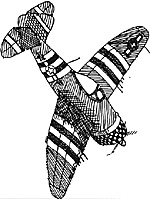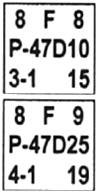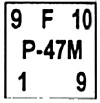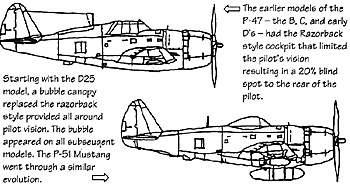 In spite of the corpulent Thunderbolt's resemblance to a jug, the nickname was originally a term of derision by RAF pilots because they said the American pilots were going to their doom in a Juggernaut. What's a juggernaut? The Random House dictionary informs us that the term was orginally jagannath, an idol of Krishna, with a shrine at Puri, India, annually drawn on an enormous cart under whose wheels devotees are said to have thrown themselves to be crushed. Only later has it come to mean "any large overpowering force" the word also retains the meaning closer to its origins of "anything requiring blind devotion or cruel sacrifice."
In spite of the corpulent Thunderbolt's resemblance to a jug, the nickname was originally a term of derision by RAF pilots because they said the American pilots were going to their doom in a Juggernaut. What's a juggernaut? The Random House dictionary informs us that the term was orginally jagannath, an idol of Krishna, with a shrine at Puri, India, annually drawn on an enormous cart under whose wheels devotees are said to have thrown themselves to be crushed. Only later has it come to mean "any large overpowering force" the word also retains the meaning closer to its origins of "anything requiring blind devotion or cruel sacrifice."
During the Vietnam conflict the Republic F-105 Thunderchief was the premier American fighter-bomber. But before the "Thud," there was the "Jug," the Republic P-47 Thunderbolt, the largest and heaviest single-seat, single-piston-engined fighter ever to see service. This corpulent, bottle (or "jug")-shaped fighter had been the best American fighter-bomber in the Second World War (and old Thunderbolt pilots still swear it was the best fighter of all). Both the Thunderchief and the Thunderbolt were creations of Alexander Kartveli, Chief Engineer of Republic from 1939 through 1960. Major Alexander P. Seversky, an Emigre Russian pilot, had founded Republic in 1931 as the Republic Aircraft Corporation. Kartveli, another Russian Emigre, was the company's chief designer.
The lineage of the Thunderbolt begins with Kartveli's SEV-3, a tubby three-seat commercial amphibian floatplane with a semielliptical wing built by Republic in 1933. From the SEV-3 came the BT-18 trainer of which the Army Air Corps ordered 30. The prototype SEV-3 was reworked, first as SEV-2XP, a two-seat fighter, and then as the SEV-1XP, a single-seat fighter with retractable landing gear. In the latter form it won the competition over the Curtiss Hawk 75A to replace the P-26 Peashooter and went into production as the P-35.
By 1939 Seversky had been removed from control of Republic due to financial mismanagement. One of his more grandiose schemes had been to propose to build 100 fighter versions and 100 bomber versions of the BT- 18 for Republican Spain at a factory to be built in Mexico. In the end only the only Republic-made plane to serve in the Spanish Civil War was the prototype SEV-3. The fact that the P-35 production had been delayed and Republic had sold twenty two-seat fighters, yet another version of the SEV-3 known as the SEV-2PA, covertly to Japan had not helped his standing either. Kartveli was retained as Vice-President and Chief Engineer of the reorganized company, now named Republic Aviation Corporation.
Kartveli improved the P-35 by adding an engine-mounted two-stage supercharger. This model went into production as the P-43 Lancer. A companion design with a turbo-supercharger, built first as private venture, was ordered as the P-44 Rocket. However, all P-44 contracts were cancelled in favor of Kartveli's masterpiece: the Thunderbolt. Until Thunderbolt production could be started Republic's assembly lines were kept busy by building P-43As and P-43Bs.
As a successor to the P-44, Kartveli proposed the XP-47, a conventional American design featuring a liquid cooled engine and armed only with two machine guns. However before the XP-47 flew, based upon combat reports from Europe which showed the need for speed, firepower and protection, Kartveli carne up with something new. He took the unusual step of designing the most efficient power system possible around the new 2,000 horsepower Pratt & Whitney R-2800 Double Wasp eighteen-cylinder two-row radial engine with an immense turbosupercharger. The supercharger was located in the aft of the aircraft and then the fuselage was designed around it. The result was the XP-47B which first flew on 6 May, 1941.
Intended as a strategic fighter, this aircraft was armed with no less than eight .50 caliber machine guns, and had internal tankage for 307 gallons. At 12,086 pounds it dwarfed all other single-engined fighters of the time. Its massive engine and four-blade propeller gave it a maximum speed of 412 mph. Its Seversky heritage was reflected in the corpulent fuselage and semi-elliptical wing.
 The P-47B was ordered "off the drawing board." However, an eight-month testing program was needed to iron out numerous teething problems, including control problems caused by flirting with the sound barrier as the Thunderbolt could exceed 500mph in a dive. Republic's plant at Farmingdale, New York, built 171 of this first variant (suffix "RE") in 1942. The 56th Fighter Group in the United States began to receive the Thunderbolt in June 1942 and was to be the service test unit for the new fighter, while the 4th Fighter Group, the former "Eagle Squadron" and already in England, replaced its Spitfires with Thunderbolts in March 1943. The 56th which became known as "Zemke's Wolfpack," after its colorful commander Col. Hubert "Hub" Zemke, became the top scoring USAAF fighter group in the ETO with 671.5 air to air kills.
The P-47B was ordered "off the drawing board." However, an eight-month testing program was needed to iron out numerous teething problems, including control problems caused by flirting with the sound barrier as the Thunderbolt could exceed 500mph in a dive. Republic's plant at Farmingdale, New York, built 171 of this first variant (suffix "RE") in 1942. The 56th Fighter Group in the United States began to receive the Thunderbolt in June 1942 and was to be the service test unit for the new fighter, while the 4th Fighter Group, the former "Eagle Squadron" and already in England, replaced its Spitfires with Thunderbolts in March 1943. The 56th which became known as "Zemke's Wolfpack," after its colorful commander Col. Hubert "Hub" Zemke, became the top scoring USAAF fighter group in the ETO with 671.5 air to air kills.
 Despite its impressive fuel capacity, the Thunderbolt's range was
still too short for bomber escort. To cure this problem the next
variant, the P-47C, of which 602 were built, was equipped to carry a belly
tank. In combat, the P-47 could outdive any other Axis or Allied
fighter and could outturn its German opponents if it maintained its
speed. Unfortunately, the early model P-47s had an abysmal climb
rate. As all P-47Bs and P-47Cs served with the Eighth Air Force, no
counters appear for them in SF, although John Astell has rated them
in TEM #42 as P-47B 6F8 1/10 and P-47C 7F8 2/11.
Despite its impressive fuel capacity, the Thunderbolt's range was
still too short for bomber escort. To cure this problem the next
variant, the P-47C, of which 602 were built, was equipped to carry a belly
tank. In combat, the P-47 could outdive any other Axis or Allied
fighter and could outturn its German opponents if it maintained its
speed. Unfortunately, the early model P-47s had an abysmal climb
rate. As all P-47Bs and P-47Cs served with the Eighth Air Force, no
counters appear for them in SF, although John Astell has rated them
in TEM #42 as P-47B 6F8 1/10 and P-47C 7F8 2/11.
 With the P-47D, production hit its stride and a new plant was built in Evansville, Indiana, to produce the Thunderbolt (suffix "RA"). Increasing demand for the fighter brought Curtiss Aircraft Corporation and its plant at Buffalo, New York, into the picture. Curtiss built 354 P-47Ds under the designation of P-47G (suffix "CU"). Despite the fact that the Curtiss-built "Gs" were identical to the Republic built "Ds," pilots found them to be of inferior quality and no self-respecting Thunderbolt pilot would fly a "G" if he had a choice.
With the P-47D, production hit its stride and a new plant was built in Evansville, Indiana, to produce the Thunderbolt (suffix "RA"). Increasing demand for the fighter brought Curtiss Aircraft Corporation and its plant at Buffalo, New York, into the picture. Curtiss built 354 P-47Ds under the designation of P-47G (suffix "CU"). Despite the fact that the Curtiss-built "Gs" were identical to the Republic built "Ds," pilots found them to be of inferior quality and no self-respecting Thunderbolt pilot would fly a "G" if he had a choice.
Again, the early model Ds were flying escort missions with the Eighth Air Force and do not receive an SF counter. As the early model D and Curtiss built G are identical they have been rated by John Astell as P-47D 8F8 3-1/15.
The Eighth Air Force successfully used the Thunderbolt as a high altitude, long-range escort fighter, but also found it to excel at ground attack. Its rugged construction and air-cooled Twin Wasp radial engine could absorb much more damage than the P51D Mustang with its liquid-cooled Merlin engine. Thus the decision was made to transfer most Thunderbolts to the Ninth Air Force, which was to provide tactical air support to the invading Allied Expeditionary Force. Likewise, Twelfth Air Force in Italy began to re-equip with Thunderbolts for tactical air support.
Some 5,777 early series P-47Ds were built (including the Curtiss P-47Gs). Fittings were added to allow the aircraft to carry bombs and more drop tanks. Like its predecessors, the D model featured the "razor-back" canopy that was found to give a 20-degree blind spot to the rear. This defect was cured in the in which the rear fuselage was cut down and a clear-vision, "bubble" canopy fitted. The D-25-RE (Farmingdale)/D-26-RE (Evansville) and later variants combined all of the improvements which made the Thunderbolt both a long-range escort fighter and fighter-bomber.
With an up-rated engine featuring menthol-water injection and a paddle-bladed propeller, the Thunderbolt could now both outclimb and outdive its German opponents. Increased fuel capacity in internal and external tanks, allowed the Thunderbolt to fly all the way to Berlin. In all some 7,179 clear vision D model Thunderbolts were built at Farmingdale and Evansville bringing the total number of the D serves built to over 12,000. The P-47D10 8F8 3-1/15 counters of SF represent the early "razorback" models; while the P-47D25 8F9 4-1/19 counters represent the later "bubble canopy" models which could carry more ordnance, fly farther and climb faster.
Besides serving in the ETO and MTO, Thunderbolts saw action in the Pacific. 240 early model P-47Ds (designated "Thunderbolt I") and 590 late model P-47Ds (designated "Thunderbolt II") were supplied to the RAF which used them as fighter-bombers in Burma, equipping sixteen squadrons. The Free French received 446, equipping GC ("Groupe de Chasse") 11/3 Dauphine, III/3 Ardennes, 1/4 Navarre, 11/5 Lafayette, and III/6 Roussillon by the end of the war and the Soviets received 195. The "I Grupo de Aviacio de Caca" (1st Fighter Aviation Group) of the Brazilian Air Force saw eight months of combat in Italy in 1944 attached to the Twelfth Air Force's 350th Fighter Group and equipped with P-47D-25-REs. In 1986 this unit received the American Presidential Unit Citation, which had been approved 40 years earlier but which had been lost in the Pentagon. "Escuadron Aereo de Pelea 201 de la Fuerza Area Expedicionaria Mexicana" (201" Fighter Squadron of the Mexican Expeditionary Air Force) flew ground support missions from June 1945 until VJ Day in the Philippines using, at first, cast-off USAAF early model P-47Ds, and then new P-47D30-RAs.
Besides the initial XP-47B prototype, several experimental models were built to test special features. These included the XP-47E with a pressurized cockpit, XP-47F with laminar-flow wings, XP-47H with an experimental 2,300hp liquid-cooled Chrysler engine' XP-47J with a closely cowled Twin Wasp engine, XP-47K which tested the clear vision canopy of the P47D-25-RE, and the XP-47L which featured increased internal fuel capacity adopted for production fighters. The J model was the fastest Thunderbolt of all and was the first propeller driven fighter to exceed 500mph in level flight, reaching 504mph.
 The appearance of the German jet and rocket 97F 10 fighters as well as the V-1 in 1944 caused the creation of the P-47M, a "sprint" model with an uprated engine, more powerful supercharger, and increased internal fuel capacity. Equipped with dive brakes and stripped of all wing racks, the M could reach 470mph with a range of 560 miles as it had no drop tanks. All 130 that were built were sent to the ETO beginning in December 1944. The lone P-47M 9F10 1/9 counter in SF represents this aircraft, although this model was flown solely by "Zemke's Wolfpack," of the Eighth Air Force and never served with Ninth Air Force on the Continent.
The appearance of the German jet and rocket 97F 10 fighters as well as the V-1 in 1944 caused the creation of the P-47M, a "sprint" model with an uprated engine, more powerful supercharger, and increased internal fuel capacity. Equipped with dive brakes and stripped of all wing racks, the M could reach 470mph with a range of 560 miles as it had no drop tanks. All 130 that were built were sent to the ETO beginning in December 1944. The lone P-47M 9F10 1/9 counter in SF represents this aircraft, although this model was flown solely by "Zemke's Wolfpack," of the Eighth Air Force and never served with Ninth Air Force on the Continent.
 The final production model, the P-47N, was designed expressly as a long-range fighter for use in the Pacific. With the internal fuel capacity and engine P-47N of the M model, the N received redesigned and 4-1 14 strengthened wings of greater span and area. For the first time, the Thunderbolt's wings contained internal tanks. The internal tanks of all prior models were housed solely in the fuselage. With external fuel tanks, this gave the N a range of 2,350 miles with a top-speed of 460mph. N flew long range escort and ground attack missions over Japan and China from bases on Saipan and the Ryukyus. 413th Fighter Group, based on Ie Shima, was commanded by Colonel Harrison R. Thyng who had become an ace flying Spitfires in North Africa in 1942-1943 and who would acquire some notoriety in post-war America as a right-wing politician. Some 1,816 Ns were built by VJ Day. As the N was used solely in the Pacific, there is no counter for in SF although presumably it would appear in Glory. John Astell has rated it in TEM #42 as 9F9 4-1/14.
The final production model, the P-47N, was designed expressly as a long-range fighter for use in the Pacific. With the internal fuel capacity and engine P-47N of the M model, the N received redesigned and 4-1 14 strengthened wings of greater span and area. For the first time, the Thunderbolt's wings contained internal tanks. The internal tanks of all prior models were housed solely in the fuselage. With external fuel tanks, this gave the N a range of 2,350 miles with a top-speed of 460mph. N flew long range escort and ground attack missions over Japan and China from bases on Saipan and the Ryukyus. 413th Fighter Group, based on Ie Shima, was commanded by Colonel Harrison R. Thyng who had become an ace flying Spitfires in North Africa in 1942-1943 and who would acquire some notoriety in post-war America as a right-wing politician. Some 1,816 Ns were built by VJ Day. As the N was used solely in the Pacific, there is no counter for in SF although presumably it would appear in Glory. John Astell has rated it in TEM #42 as 9F9 4-1/14.
Despite its fearsome reputation as a tactical fighter, no P-47s saw combat in Korea where the more vulnerable P-51 initially undertook this task. The Mustangs took significant losses to ground fire in this role. Unfortunately, by this time all P-47s had been assigned to Air National Guard units and supplied to various foreign air forces such as Turkey, Iran, Yugoslavia, and those of many South American countries. However, yet another Kartveli design, the F-84 Thunderjet was used with some success as a fighter-bomber. Its swept wing development, the F84F Thunderstreak became a NATO mainstay. The retirement of the F-105 did not see the end of the Thunderbolt's heirs, for in 1991 the Fairchild Republic A-10, fittingly named "Thunderbolt II," took on the Iraqis in DESERT STORM, wreaking havoc in the desert on everything from tanks to Scuds.

Back to Europa Number 59-60 Table of Contents
Back to Europa List of Issues
Back to MagWeb Master Magazine List
© Copyright 1997 by GR/D
This article appears in MagWeb (Magazine Web) on the Internet World Wide Web. Other military history articles and gaming articles are available at http://www.magweb.com